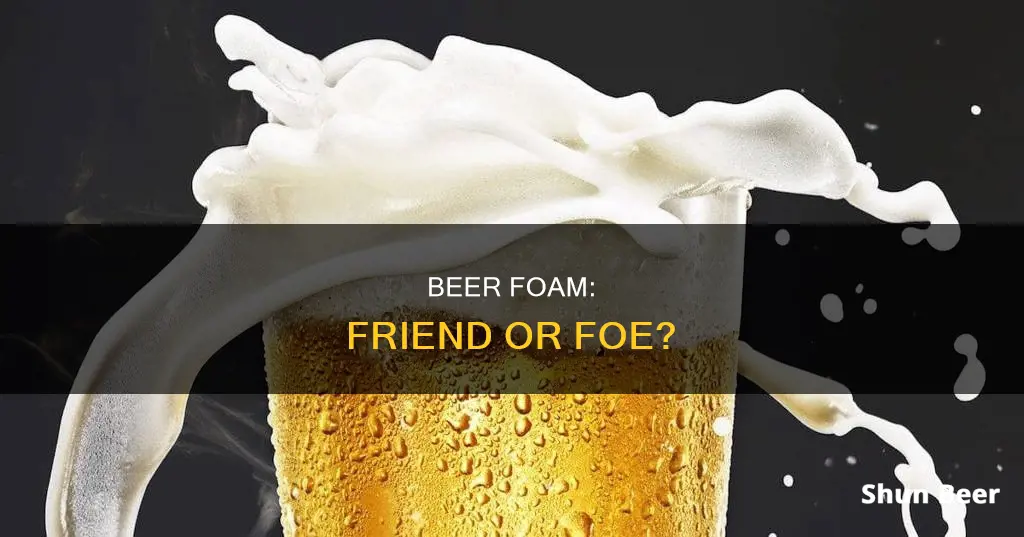
Beer foam is often seen as undesirable, with many people believing that a slow, steady pour that avoids foam is best. However, this notion is being challenged by beer experts, who argue that a thick ring of foam is not only beneficial but an essential part of the drinking experience. This foam, created by carbon dioxide, enhances the aroma and flavour of the beer, adds a subtle creaminess, and prevents bloating by releasing gas before the beer reaches the stomach. So, the next time you pour a beer, don't shy away from a foamy head—it might just improve your drinking experience.
| Characteristics | Values |
|---|---|
| Prevents bloating | Beer foam releases carbon dioxide, preventing it from building up in your stomach and causing bloating. |
| Enhances aroma | The foam carries aromatic compounds, improving the complexity and flavour of the beer. |
| Affects mouthfeel | The density of the foam gives the beer a creamy quality and a sense of fullness in the mouth. |
| Looks appealing | A thick, creamy foam looks great and is often considered the "perfect pour". |
What You'll Learn

Beer foam enhances the aroma and flavour of the beer
Beer foam is an important part of the drinking experience. It is not only visually appealing but also has a positive impact on the aroma, flavour, and mouthfeel of the beer.
The foam on a glass of beer is a result of carbonation. When beer is poured, carbon dioxide is released, forming bubbles that create a collar of foam. This foam plays a crucial role in enhancing the aroma of the beer. As the carbonation escapes from the liquid, it carries with it aromatic compounds that provide hints of the flavours present in the beer. By capturing and releasing these aromatic compounds, the foam acts as a sensory prelude to the taste of the beer.
The aroma of beer is closely linked to its flavour, and the presence of foam can significantly influence the overall taste experience. The foam helps to retain and accentuate the complex flavours crafted by brewers, ensuring that drinkers can fully appreciate the intended aromas and flavours.
Additionally, the density and texture of the foam contribute to the mouthfeel of the beer. A thick, creamy head of foam adds a subtle creaminess and a sense of fullness on the tongue, enhancing the smoothness of the beer. This is particularly noticeable in wheat beers, such as hefeweizens, farmhouse ales, and beers brewed with oats and rye.
The amount and quality of foam can vary depending on several factors, including the brewing process, ingredients, carbonation level, serving glass, and pouring technique. A proper beer pour involves tilting the glass slightly at the beginning and then returning it to an upright position as the beer settles, allowing the foam to form. This method ensures the release of carbon dioxide and helps prevent bloating.
In summary, beer foam is much more than just a decorative topping. It enhances the aroma and flavour of the beer, improves the mouthfeel, and contributes to a more enjoyable drinking experience overall. So, the next time you pour yourself a cold one, embrace the foam and savour all the nuances it brings to your favourite brew.
Drinking Beer in Brussels: What You Need to Know
You may want to see also

Foam prevents bloating by releasing carbon dioxide
Beer foam is often misunderstood and underappreciated. It is formed by the carbonation in beer, which is released when the beer is poured. This carbonation is essential to the beer-drinking experience, as it enhances the aroma and flavour of the beer. However, it can also lead to bloating if not released properly before consumption.
The key to preventing bloating is to allow the carbon dioxide to escape from the beer before it enters your stomach. This is where the foam comes in. When a beer is poured correctly, with vigour and a slight tilt to the glass, the foam captures and releases the carbonation, preventing it from building up in your stomach.
The act of pouring the beer down the side of the glass with force creates the perfect amount of foam. This foam then acts as a protective barrier, allowing the carbon dioxide to escape and preventing it from settling in your stomach. By releasing the carbonation, the foam ensures that you avoid the uncomfortable and bloated feeling that can sometimes accompany beer consumption.
The foam also enhances the drinking experience in other ways. It adds a subtle creaminess and smoothness to the beer, improving the mouthfeel and creating a unique sensory experience. Additionally, the foam helps to release the subtle aromas of the beer, improving its complexity and enhancing the overall flavour.
So, the next time you pour yourself a beer, embrace the foam. Not only does it protect you from bloating, but it also elevates the taste, aroma, and texture of your drink. By allowing the carbon dioxide to escape, the foam ensures a more enjoyable and comfortable beer-drinking experience.
Southern Beer Breakfasts: Fact or Fiction?
You may want to see also

The perfect pour will yield 0.5 to 1 inch of thick, creamy foam
A perfect pour of beer will yield 0.5 to 1 inch of thick, creamy foam. This is the optimal amount of foam for a few reasons. Firstly, it looks great. Secondly, it can add a subtle creaminess to the beer, enhancing the mouthfeel and making it feel smoother as you drink it. Thirdly, it helps to release the subtle aromas of the beer, improving its complexity and taste. Lastly, it helps to release some of the carbonation, reducing the amount of gas that ends up in your stomach, which can cause bloating.
To achieve this perfect pour, start with the glass tilted at a 45-degree angle. Slowly pour the beer onto the side of the tilted glass until it is at least halfway full. Then, return the glass to an upright position and pour the rest of the beer into the centre. The head of foam should start forming. Ensure that you do not overfill the glass.
The quality of the foam depends on several factors, including how the beer was brewed, the ingredients used, the level of carbonation, the serving glass, and the pouring technique. For example, beers brewed with oats and rye tend to produce excellent heads of foam. On the other hand, high-alcohol beers like barley wines and imperial stouts tend to have less foam because alcohol inhibits foam formation.
The foam on a beer is not just a waste of space in your glass. It enhances the drinking experience by improving the aroma, taste, and mouthfeel of the beer. So, the next time you pour yourself a beer, don't be too quick to dismiss the foam!
Beer and Chemo: What You Need to Know
You may want to see also

Beer foam improves the mouthfeel of the beer
Beer foam is not just about appearance. It has a significant impact on the drinking experience, including the mouthfeel of the beer.
The texture of the foam lends a smoother, more luxurious mouthfeel to the beer. The foam can add a subtle creaminess to the beer, making it feel smoother and more luxurious as you drink it. This creaminess can make the beer easier to drink and enhance the overall experience.
The creation of foam is a result of the trapped carbon dioxide forming bubbles when beer is poured. The bubbles from the beer impact its carbonation level, aroma, flavour, and body. Each time a bubble bursts, it releases aroma particles that enhance the beer's smell and, in turn, its taste. The foam acts as a preview of the beer's flavour, setting the stage for the first sip.
The foam is not separate from the beer; it is an integral part of it, just in a different form. The foam eventually turns into beer, and the carbonation is released from the liquid, carrying with it aromatic compounds that enhance the complexity and flavour of the beer.
The perfect pour will yield about half an inch to one inch of thick, creamy foam. This helps capture the released carbonation and creates a smooth and creamy sensation when drinking, while also keeping the extra gas out of your stomach.
A Day in the Life of a Brewery Worker
You may want to see also

Beer foam is a sign of good things to come
Firstly, a good head of foam can add a subtle creaminess to the beer. This light creaminess can make the beer feel smoother and fuller on the tongue, improving the mouthfeel of your beer. This sensation is particularly noticeable with hefeweizens, farmhouse ales, and other wheat beers.
Secondly, the foam can help to release subtle aromas, which can improve the complexity and taste of the beer. As the carbonation is released from the liquid, it carries with it aromatic compounds, giving you hints of what you can expect from the beer. So, take a deep breath and appreciate those aromas as your beer settles.
Thirdly, a good beer pour with a head of foam can help to prevent beer bloat. When beer is poured without any foam, the carbon dioxide stays dissolved in the beer. Then, when you eat something after drinking the beer, the carbon dioxide is released in your stomach, causing bloating. By allowing the beer to foam, you give the carbon dioxide a chance to escape before it reaches your stomach, resulting in a more comfortable drinking experience.
Finally, a thick head of foam on a beer is simply aesthetically pleasing. It is the mark of a perfectly poured pint and can enhance the overall enjoyment of your drink. So, the next time you pour yourself a beer, don't be too quick to dismiss the foam. Embrace those bubbles and all the benefits they bring!
Drinking Beer and Playing Saxophone: A Harmful Combo?
You may want to see also
Frequently asked questions
Foam helps to release the carbonation in beer, reducing the amount of gas that ends up in your stomach, and preventing bloating.
When beer is poured without foam, the carbon dioxide stays dissolved in the beer. When you eat something after drinking, the carbon dioxide is released in your stomach, causing bloating.
The aroma of the foam improves the complexity and flavour of the beer. As the carbonation is released from the liquid, it carries with it aromatic compounds that give hints of the beer's flavour.
Foam adds a subtle creaminess to the beer, making it feel smoother and enhancing the mouthfeel.
A good beer pour should include around half an inch to one inch of foam.







